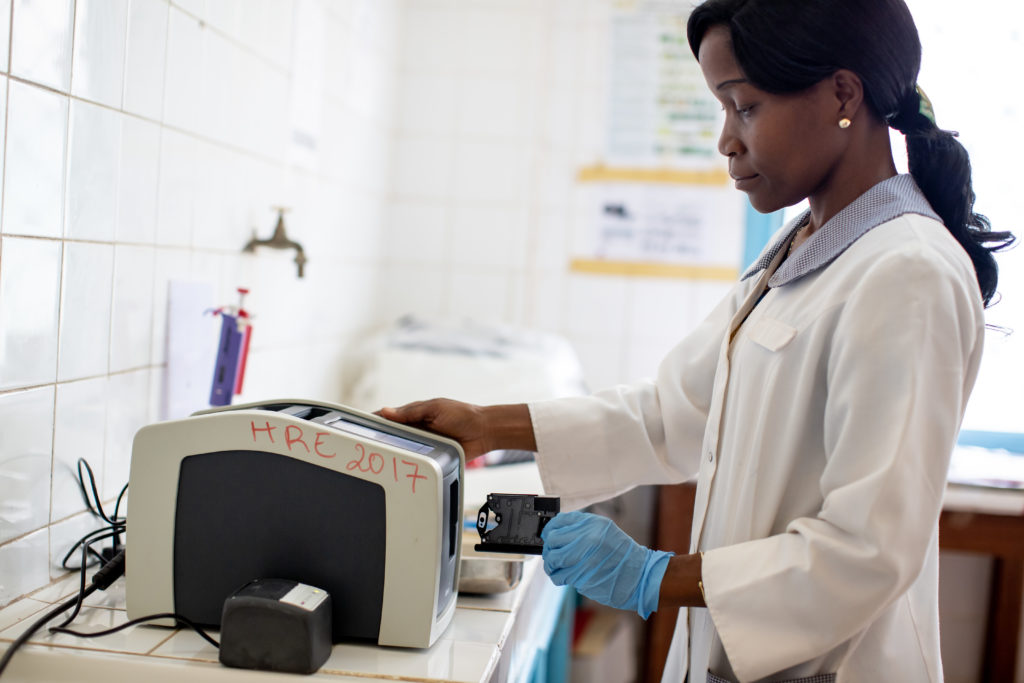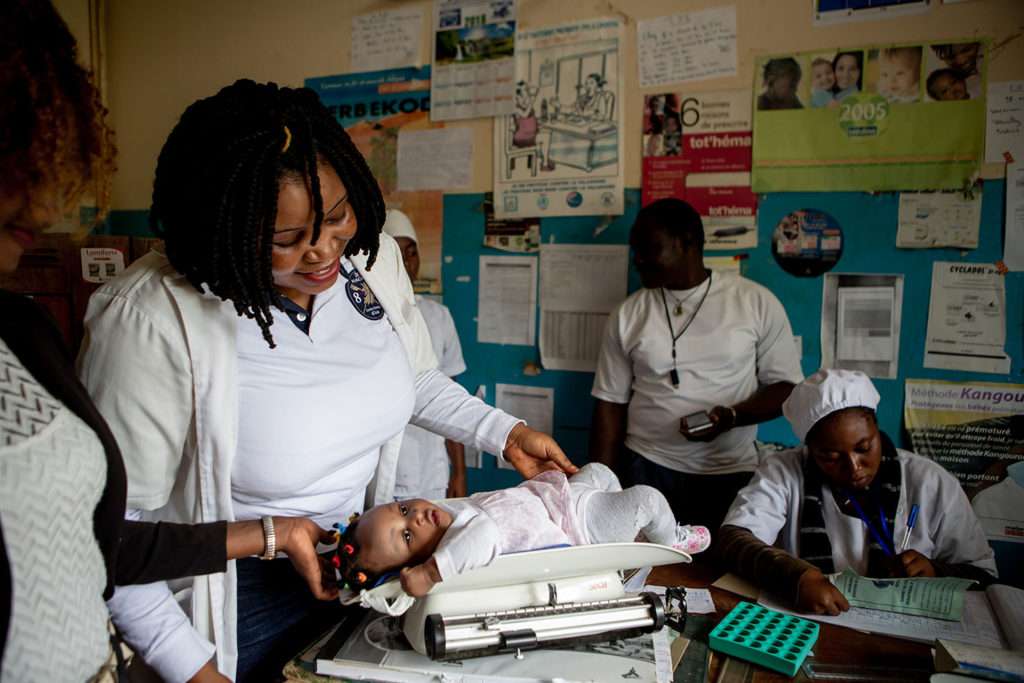After five hours hunched in a crowded minibus, three hours trying to soothe a crying baby, and one hour waiting to see a healthcare worker, she had made it. This Malawian mother had finally made it to a health facility to test her baby for HIV.
Despite the hours of travel, she soon learned that she may have to wait up to three months for a test result because the facility had to send the test sample to one of the country’s few centralized labs to be processed. With additional children and responsibilities at home, she worried if she would be able to make it back to find out if her baby had HIV.
Of all HIV-exposed infants worldwide, only 50 percent receive a timely early infant diagnosis (EID) test. Of those, only half receive their results due to long turnaround times and high rates of loss-to-follow-up. Unfortunately, without treatment, nearly half of HIV-infected children die by the age of two, with 20 percent dying in the first two to three months of life.
Recognizing that timely diagnosis and initiation to treatment are critical to reducing the number of infants dying from HIV, the Clinton Health Access Initiative, Inc. (CHAI), UNICEF, and African Society for Laboratory Medicine (ASLM) received funding from Unitaid in 2012 to accelerate access to point-of-care (POC) testing for EID of HIV across 10 countries in sub-Saharan Africa.
Point-of-care technology can change infant diagnosis
Diagnosing HIV in infants is more challenging than in older populations because infants may test positive for HIV on a rapid test and not actually have it. This is because many of the tests administered are checking for HIV antibodies, which infants can carry from their mothers for up to 18 months. As a result, more complex nucleic acid testing (NAT), which has traditionally only been available at centralized laboratories, is required to accurately diagnose HIV in infants.
In contrast, POC technologies are smaller, simpler, robust devices that can be used by non-laboratory staff at clinics within communities. Test results are ready onsite, the same day. If strategically placed, POC EID could significantly increase the number of HIV-positive infants who are identified and initiated on treatment and broaden the community’s access to care.

Lab technician Lydia Nyatte, at Ebolowa Regional Hospital in Cameroon, conducts a POC EID test using the Abbott mPima platform. Since the implementation of the device patients now receive same day testing, same day results and same day medication. ©UNICEF/Karin Schermbrucker/Cameroon/2018
“The introduction of POC technologies presents an opportunity to provide accurate, rapid, on-site testing that enables a mother to receive the result of this critical HIV diagnostic test and receive appropriate care for her infant in one visit, as opposed to needing to make multiple trips to the health facility to learn her infant’s HIV status,” said Jilian Sacks, Senior Scientist for the Laboratory Services Team at CHAI.
Evidence for adopting point-of-care early infant diagnosis
With Unitaid support, CHAI collaborated with its partners, including UNICEF and the ministries of health (MOHs) in Malawi and Mozambique, to launch pilots to demonstrate how POC EID successfully reduces result turnaround time and increases the number of HIV-positive infants identified and initiated on antiretroviral therapy (ART).
In Malawi, CHAI collaborated with the MOH in an observational study at seven health facilities. The pilot showed that 91.1 percent of infants diagnosed with HIV using POC EID were initiated on treatment, compared to the 45.8 percent of those who were diagnosed using the conventional, referral-based system. Additionally, with POC EID, 99 percent of results were returned to infants and caregivers within the same day, compared to 0 percent using conventional EID.
“The Malawi MOH is drafting a national scale-up and implementation plan for POC EID and viral load based on evidence from the pilots and the proven implementation model for POC CD4,” said James Kandulu, Deputy Director, Health Support Technical Services, Malawi MOH.
In a cluster randomized control trial in Mozambique, CHAI collaborated with the National Institute of Health to show that 89.7 percent of infants diagnosed using POC EID were initiated on treatment within 60 days, compared to the 12.75 percent through conventional EID. Furthermore, 99.2 percent of POC EID results were returned within 60 days, compared to just 7.2 percent in conventional testing. Both studies showed that the cost to administer POC EID may also be lower than conventional tests.
“While the cost of conventional testing may appear lower, the number of patients who never receive their results actually drives up the cost per test,” said Seth McGovern, Senior Manager of HIV Diagnostics for CHAI. “As a result, POC EID is actually more efficient because it accurately diagnoses more patients and returns their results, thus starting more infants on ART and directly addressing the problem.”
The pilots found that strategic placement and implementation of POC EID devices can increase the number of HIV-positive infants on ART. Both studies found that placement of POC devices at facilities with pediatric ART services was critical to ensure linkage to care, and that modifications in clinical workflow were required to allow same-day sample collection, result return and ART initiation.

Rose Mekinda, a peer counselor at Ebolowa Regional Hospital in Cameroon, weighs a baby, preparing for POC EID testing. In the past, Rose struggled to get mothers to test their babies at 6 weeks – due to the delay in receiving results. ©UNICEF/Karin Schermbrucker/Cameroon/2018
In a collaborative study between CHAI and the Central Public Laboratories of the Republic (CPHL) of Uganda, investigators found that offering EID outside of traditional prevention of mother-to-child transmission (PMTCT) programs resulted in higher numbers of HIV-positive infants. This finding suggests that increased efforts are needed to identify infants outside of traditional PMCT channels. The pilot in Malawi also diagnosed a high number of infants outside of PMTCT. Together, these findings suggest that placement of POC EID devices at alternative facility entry points, such as pediatric in-patient wards, as well as universal re-testing of mothers for HIV, could help to find infants who may otherwise not be tested.
“Conducting EID testing at the point-of-care provides a novel approach to reaching vulnerable infants with rapid and clinically relevant test results with an easy-to-use technology,” said Lara Vojnov, Diagnostics Advisor, HIV and Hepatitis Department at the World Health Organization. “The evidence to date has been overwhelmingly positive, showing significant reductions in test turnaround times, as well as increased rates of treatment initiation for HIV-infected infants. This innovation may provide a key link to ensuring access to life-saving treatment services for HIV-infected infants.”
Expanding point-of-care early infant diagnosis into the future
With support from Unitaid, CHAI and partners continue working toward a future free of pediatric AIDS by helping MOHs introduce and scale up POC EID testing programs. With the potential to reduce result turnaround times, increase the percentage of results returned to patients and improve linkage to treatment, POC EID provides an opportunity to close the HIV testing and treatment gaps for infants. This way, more mothers, like the one in Malawi, will be confident that their healthcare systems can deliver results and the medical care that their babies need.





